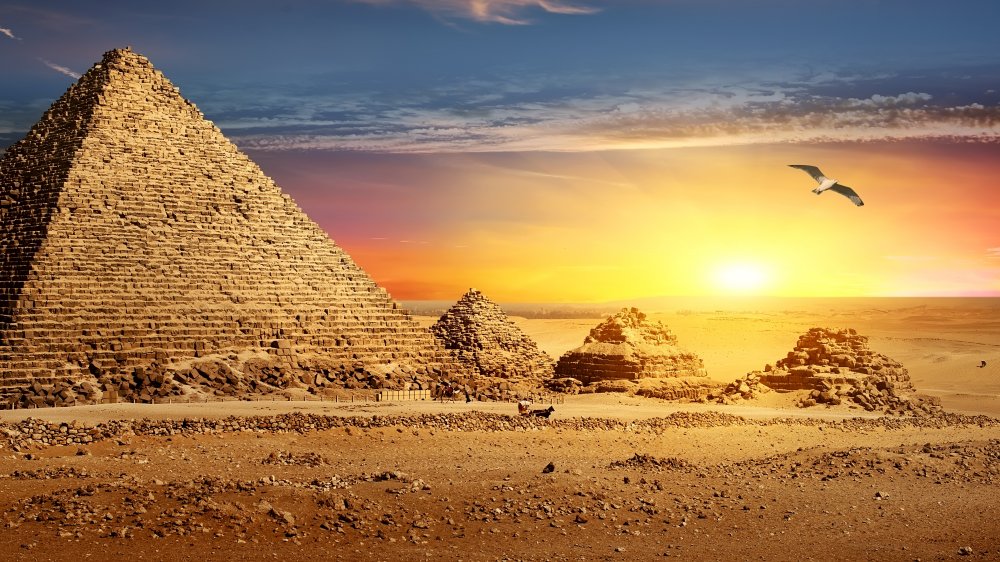Here's How The Egyptian Calendar Differs From The Gregorian Calendar
The human species has worked hard to add a layer of organization to the passage of time, and there have been some interesting solutions. The Mayans and the Aztecs, for example, opted for the elegance of intricately carved discs. The Ancient Greeks, true to cerebral form, devised what historians now refer to as the Antikythera Mechanism — a ridiculously complex device that may have been the world's first known computer. The Ancient Egyptian and the Gregorian calendars are just two solutions of many, but they're interesting placed side by side, because both calendars attempt to address a persistent temporal problem that has plagued civilization ever since humans looked up at the sky and wondered what that big shiny thing was.
First, though, some basic points of comparison. The Ancient Egyptian solar calendar was devised around 4,000 BCE and, according to Britannica, it's the first known calendar to record time using a 365-day year. The Gregorian Calendar was proclaimed in 1582 CE by Pope Gregory XIII, according to Wired, and to this day remains the internationally agreed-on calendar to record time. It's arguably the best known tool for figuring out how many days you have to wait until you next get birthday cake.
Here's how the calendars work
Hopefully the education system has served you well, and you pretty much get the gist of how the Gregorian calendar works. You've got your twelve months. The length of these is either 28, 30 or 31 days long (remember the poem? 30 days hath September...), and then you have that tricky leap year thingy, where February occasionally decides to hang around for another day. The Egyptian calendar arrives at 365 days quite differently. As Ancient Egypt Online explains, there were three weeks of ten days in a month. Four months made a season. Three seasons and five additional holy days made a year. And voila! You have a grand total of 365 days.
So, why three seasons instead of four? Given Egypt's climate and its dependence on Nile floods, three seasons makes perfect sense. The first season was called Akhet, meaning flood. The second was named Proyet, meaning emergence or growth. The third season was named Shomu, which means low water or drought. These three yearly phases marked the distinct chapters of growing crops, raising animals, and generally pursuing the whole messy business of staying alive.
Back to the time problem
So, back to the pesky time problem both calendars were built to resolve.
Remember those five holy days the Egyptian calendar tacked on to the end of its civic year? These weren't plonked there as an excuse to take a mental health break from building pyramids. They were introduced around 4,000 BC in an attempt to keep Egypt's civic calendar in sync with the solar year. It worked, more or less. The calendar was still off by about one-quarter of one day every solar year, and as Britannica explains, this inaccuracy meant that the seasons made a complete cycle through the solar year every 1,460 years. In other words, at the 700-year point in this cycle, the season named Akhet (or flood) would happen slap-bam in the middle of the driest part of the year. In 46 BCE, Julius Caesar cast the Ancient Egyptian calendar aside, in favor of the Julian calendar, which incorporated that four-yearly leap year you know and love (okay, maybe not love) today.
Fitting a square idea of time into a solar system-sized hole
Flash forward to Sixteenth Century BCE, and the Julian Calendar remains the birthday cake measurer du jour across Europe. But it wasn't perfect. The leap year definitely improved how accurately we could measure time, but it was still off by around 11 minutes every year. This might seem a paltry discrepancy, but as History explains, in 1582, Pope Gregory XII was losing sleep over how Easter (traditionally March 21) was gradually drifting away from the Spring Equinox. Because, um ... it was a pope's job to worry about such matters.
The Gregorian calendar was brought in to fix this sorry state of affairs, and it did so, by getting fancy with leap years. Here's how it works, courtesy the friendly temporal experts over at TimeAndDate.com: To identify a leap year, first, find a year divisible by four. Then, check whether it can be evenly divided by one hundred. If it can, no leap year for you! Oh, unless it's also divisible by 400, in which case a leap year it shall be. It's all weirdly complicated, but what you're left with is the most accurate calendar ever placed into common usage.
Is it perfect? Nope. Not from the solar system's point of view, at least. You gain 26 seconds per year, which means that — steel yourself for this grave news — the Gregorian calendar will be a full day out of whack by the year 4909.



